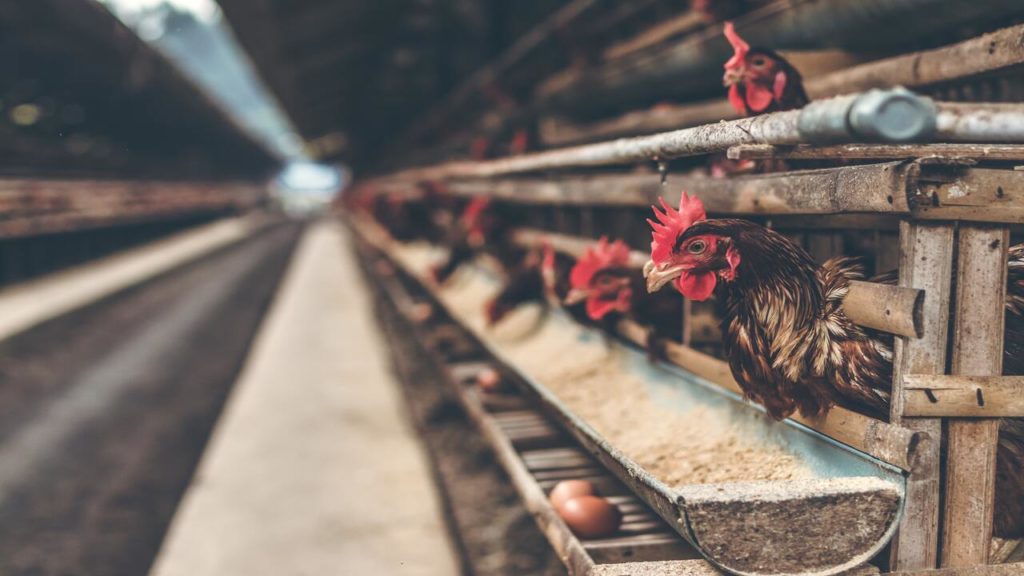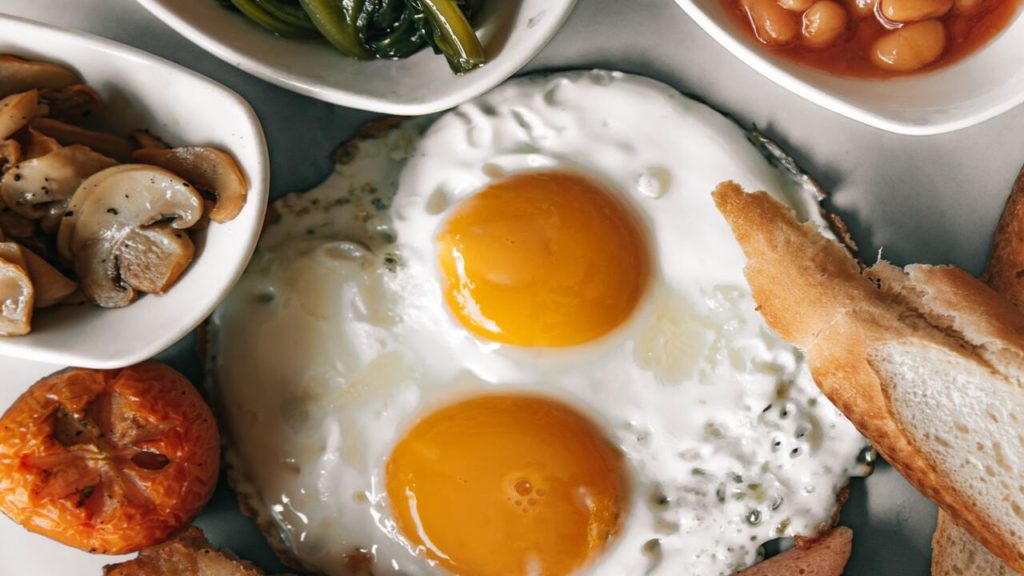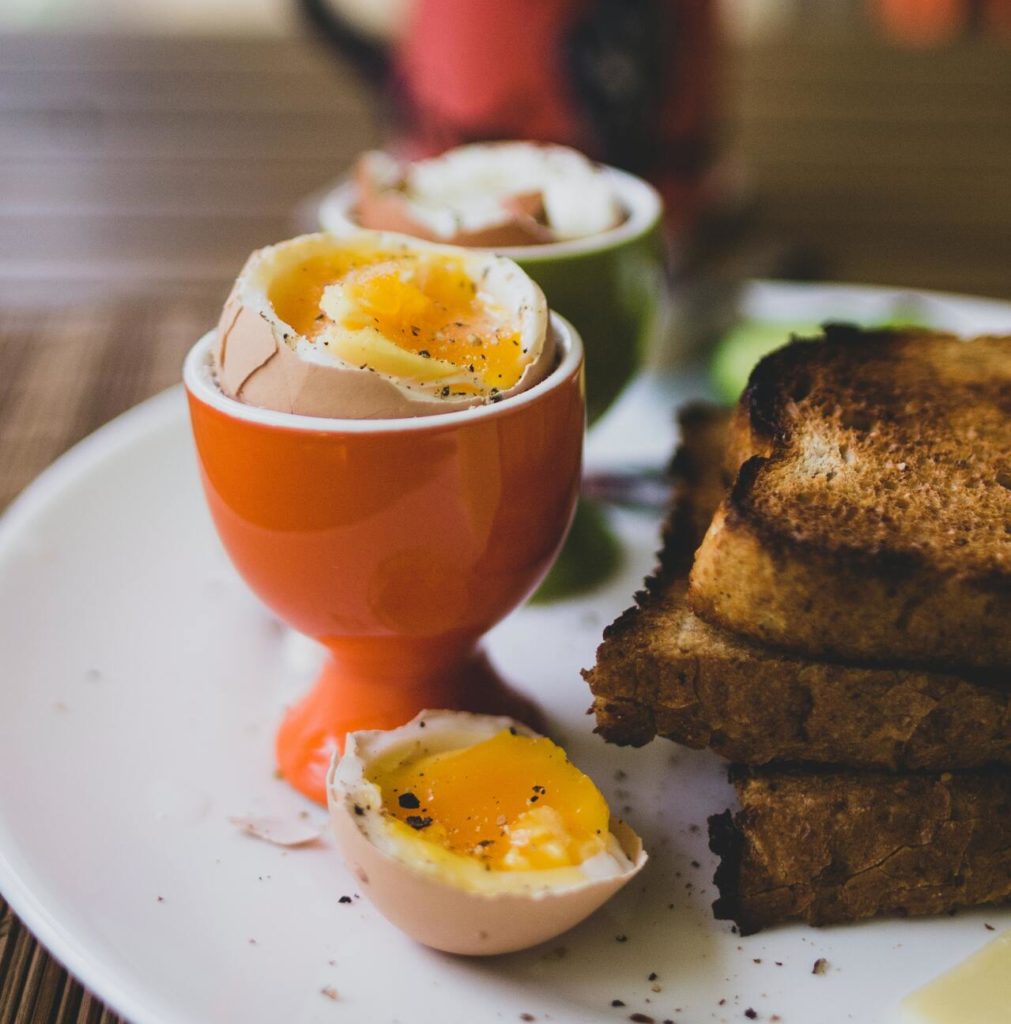Eggs are nature’s masterpieces, ranging from natural white to light brown and with a perfect aerodynamic shape.
Surprisingly versatile, they are present on every table, from Michelin-starred restaurants to modest homemade dishes relished at breakfast, lunch, and dinner.
However, before cracking them, it is wise to understand what is going into our skillet or mixing in the dough, how farmers raise chickens, the egg’s nutritional values, how to handle them safely, and much more.
It may be the cock that crows, but it is the hen that lays the eggs.
-Margaret thatcher – Britain’s prime minister
Jump To Section
- The Eggs Universe
- What is an Egg, Exactly?
- The Egg Anatomy
- Egg Sizes And Weights
- Egg Grades
- Which Eggs Are Considered The Best?
- Health Benefits of Eggs
- Egg Safety
- Different Ways To Cook Eggs
- Eggs: Facts & Curiosities
The Eggs Universe

When we buy eggs, we usually expect them to come from a hen; however, goose, duck, quail, and ostrich also play an essential culinary role.
The favoritism for hen eggs dates back to 6000 BC in Thailand, where chickens were favored for laying continuously.
In the 20th century, egg producers were favored economically with increased food demand. Consequently, they focused on increasing their productivity by raising laying hens in an intensive confinement system where poultries spend their entire lives in small, cramped cages.
Laying hens in cages are among the most intensely confined animals in agribusiness. They suffer from restricting many natural behaviors essential to their well-being, such as nesting, perching, and dust bathing.
Today, consumers are seeking alternative sources, such as organic products avoiding eggs from confined laying hens, which resulted in a push for the European Union and the United States to pass regulations to eliminate intensive confinement systems.
What Is An Egg Exactly?
Does the egg come before the chicken? This is an age-old question that cracks our brains.
According to Harold McGee, author of On Food and Cooking: The Science and Lore of the Kitchen, “Eggs existed long before chickens.”
Around 250 million years ago, the reptiles developed a self-contained egg with tough, leathery skin that prevented fatal water loss.
One hundred million years later, birds’ eggs arose, a refined version of the reproductive adaptation to life on land. Therefore, eggs are millions of years older than birds.
Gallus domesticus, the chicken as we know it, is about 4 or 5 thousand years old.

An egg is a 56-gram palm-sized organic vessel and is one of our most nutritionally complete foods.
A chicken egg can be either fertilized or unfertilized. A chicken is born with a full complement of eggs and will produce many of them over the year, regardless of whether a rooster is lurking about.
So, a hen does not depend on the rooster to produce eggs, but the male’s participation is essential for fertilization, which means the pop-up of a chick.
Chickens have thousands of tiny ovum, which are undeveloped yolks in their ovary that will be released once matured, and then the extraordinary journey of development begins.
It takes approximately 25 hours for ovulation to lay when the egg leaves the ovary. During this time, the yolk will develop and become covered by the albumen, wrapped in a membrane, and finally enclosed in a shell. Then about 30 minutes later, the hen will begin to make another one.
White and brown eggs are from different hen breeds, and there is no connection to the hen’s feathers’ color, but they have the same nutrient values.
The yolk color varies from pale yellow to deep orange, depending on the hen’s diet. Orange yolks indicate that hens were fed with carotenoid dosages, while pale yolks indicate wheat consumption.
The Egg Anatomy
It is no secret that we expect to see only the yolk and egg white when we break an egg on a white plate. However, there are other essential parts that we may not realize. Let’s understand what they are and their importance.

Shell
It is the hard outer layer and grainy texture made almost entirely of calcium carbonate (CaCO3) and covered with thousands of tiny pores, where the air and moisture can pass through – this explains why it can sometimes absorb odors in the fridge.
Inner and Outer Membranes
Located between the shell and egg white, these two transparent protein membranes are an efficient defense against microorganism invasion.
Vitelline membrane
It is the membrane that surrounds and protects the yolk.
Air cell
Have you seen the crater created at the base of a hard-boiled egg? That is the air cell. After laying, the internal parts contract creating a space between the inner and outer membranes.
Chalaza
Chalaza is two twisted membranous strips joining the yolk to the ends of the shell, holding the yolk in the shell center. With an opaque color, a prominent chalaza cord indicates that the egg is fresh.
Yolk
Yolk color ranges from yellow pale to deep orange, contains less water and more protein than white, and is rich in vitamins and minerals, such as vitamin A, vitamin D, phosphorus, calcium, thiamine, and riboflavin.
Egg white
Also known as albumen from “albus,” the Latin word for “white,” is rich in proteins and water.
Egg Sizes And Weights
Unless otherwise stated, whenever you follow a recipe that calls one egg, it means a large one with an average weight of 2.0 oz / 56 g, being:
- Shell: 0.2 oz or 5 g
- Egg white: 1 oz or 31g
- Yolk: 0.8 oz 20
The US Department of Agriculture established parameters for egg weight.
| Size | Weight per dozen | Weight per egg |
| Jumbo | 30 oz / 850 g | 2.5 oz / 70 g |
| Extra Large | 27 oz / 765 g | 2.3 oz / 65 g |
| Large | 24 oz / 680 g | 2.0 oz / 56 g |
| Medium | 21 oz / 595 g | 1.8 oz / 50 g |
| Small | 18 oz / 510 g | 1.5 oz / 45 g |
| Peewee | 15oz / 425g | 1.25 oz / 35 g |
Egg Grades
The interior quality, appearance, and shell condition are the determining factors for the eggs’ grades.
In the U.S., there are 3 categories: Grade AA, Grade A, and Grade B, while in Canada, there are 4: Canada A, Canada B, Canada C, and Canada Nest Run.
Although countries have different categories, they have the same standards for determining quality, classifying them into:
- Exterior quality: The appearance of the shells must be clean, smooth, and free of cracks.
- Interior quality: The Candling method, a test for freshness or fertility, works by holding the egg to the light, evaluating the yolk’s outline and whether it is in the center, blood spots, or embryo development.
Which Eggs Are Considered The Best?
With several different claims stamped on egg cartons – e.g., standard, organic, omega-3, and free-range – choosing which type to get isn’t a simple task. Despite which type you purchase, they deliver plenty of nutrition.
Check below which ones you’ve eaten or which ones you can still eat.
Standard
Many producers raise the laying hens in conventional “battery” cages, that is, in small and crowded spaces with equal access to food and water without access to nests and perch areas.
They cannot scratch the ground with their toes for searching seeds or bugs to eat- a natural and vital behavior for their well-being.

Organic
Laying hens are fed without growth hormones or antibiotics, only with certified organic grains.
Omega-3
In this category, hens are fed a diet containing 10 to 20% flaxseed, reducing the risk of heart disease in humans since flax contains omega-3 polyunsaturated fatty acids.
Free-run
Hens can walk and scratch the ground only of the barns without access to the great outdoors. Also, they have access to nests and perches.
Free-range
Free-range eggs are seasonal in North America because of the hard winter. Hens are free to go outdoors. In other words, their feet come in contact with the earth.

Health Benefits Of Eggs
In the 50s, health experts discovered that people with high blood cholesterol levels were suffering from heart disease.
So, they correlated blood cholesterol and egg consumption – approximately 215 milligrams/significant unity.
As a result, North Americans reduced or cut their weekly egg consumption completely.
Scientists have found that humans have absorbed very little cholesterol from eggs in the past few decades. Consequently, this new information prompted the American Heart Association to suggest that one egg a day is perfectly acceptable.
We are probably more embracing of eggs within a heart-healthy dietary pattern than we were 20 years ago, but it’s still a source of dietary cholesterol. However, eating an egg a day as a part of a healthy diet for healthy individuals is a reasonable thing to do.
Jo Ann Carson, professor of clinical nutrition at UT Southwestern Medical Center in Dallas.

At just 78 calories each, eggs are an efficient, rich source of protein and vitamins. A large egg contains about 6 grams of protein. Eggs also are a good source of other nutrients, including vitamin D (which aids bone health and the immune system) and choline (which helps metabolism and liver function).
Egg yolks also can be good for the eyes; they are significant sources of lutein and zeaxanthin, which have been found to reduce the risk of cataracts and macular degeneration, the leading cause of blindness in people 55 and older.
If the goal is to decrease fatty consumption, egg whites can be a good source once they have approximately 4 grams of protein, according to the USDA.
Egg Safety
Although eggs are usually clean when laid, they can sometimes be contaminated with Salmonella or other bacteria, causing food poisoning. That’s because the egg exits the hen’s body through the same passageway as feces is excreted.
Although bacteria are found, in most cases, in the shell itself, It is also possible for eggs to become infected by Salmonella fecal contamination through the shells’ pores after laying. This is not a problem for commercial eggs you buy at the grocery store because companies wash eggs before they reach the shelves.
The WHO estimates that nearly 600 million or 1 in 10 people fall ill due to food poisoning, and 420,000 die each year in the world. In the US, approximately 1.35 million people are infected with Salmonella annually. In these numbers are the main victims – the elderly and children under 5.
The Centers for Disease Control claims that most people who get sick from Salmonella have diarrhea, fever, and stomach cramps. Symptoms usually begin 6 hours to 6 days after infection and last 4 to 7 days. People with diarrhea should drink extra fluids.
Is it safe to eat raw or undercooked eggs?
No one should eat foods containing raw eggs or not thoroughly cooked, mainly children, the elderly, pregnant women, and people with weakened immune systems that are particularly vulnerable to Salmonella infections. A chronic illness weakens the immune system, making the person vulnerable to foodborne illnesses.
How can you reduce the risk of getting Salmonella?
When Shopping
- Choose only refrigerated eggs with clean and uncracked shells.
- Consider buying and using pasteurized egg products.
- Pick up eggs at the end of your shopping trip, so they stay cold.
Temperature Safe Zone
- Keep the eggs in the coldest section of the fridge.
- Do not keep them at room temperature for more than two hours.
- Hard-boiled eggs can be stored in a sealed container in the fridge for up to one week.
- Store eggs in the fridge at 4ºC with a relative humidity of 70% to 80%.
- Cook the eggs at an internal temperature of 74ºC for 15 seconds or longer.
- Eggs should be held for service at 60ºC for no more than two hours.
When Cooking
- Wash your hands thoroughly with warm water and soap for at least 20 seconds after handling eggs.
- Wash items that came into contact with raw eggs—including countertops, utensils, dishes, and cutting boards.
- Keep raw meat and poultry separate from produce and other foods when cooking, avoiding cross-contamination.
Different Ways To Cook Eggs
You can boil, scramble, make an omelet, fry, or poach them. Also, eggs are the protagonists of many recipes, including hollandaise sauce, crème brûlée, and muffins.
Check below the different ways to cook them:
Sunny side up

A sunny-side-up egg is only fried on one side, leaving the yolk raw and the whites just almost set, normally with lightly crispy sides.
Over easy, medium, and hard eggs
The term “over” can be explained as the action of flipping in a frying pan. So when someone asks for over……
- Easy: It means an entirely runny yolk set in gently set whites.
- Medium: It is firm whites and yolks, similar to a loose custard.
- Hard: Yolk is cooked like a hard-boiled egg’s center.
Boiled

When it comes to boiled eggs, everyone has their preferences, which can vary from liquid to hard yolk. As it is impossible to see through the eggshell, follow this quick-cooking time guide:
- Runny yolk: 3 to 4 minutes
- Soft yolk: 5 to 6 minutes
- Hard-cooked: 11 to 15 minutes
Notes: Set the timer after the water boils.
Omelets

A simple dish, but it’s also can be tricky to prepare. Follow the cooking tips below to make a perfect one.
- Whisk the eggs until just fully incorporated.
- Use a nonstick pan and use a flexible rubber spatula.
- Prefer clarified butter, which has a higher smoke point than regular butter
- Choose your fillings, such as ham, bacon, sausage, cheeses, spinach, bell peppers, and onions.
- Serve immediately after cooking.
Scrambled

The way you prepare your scrambled eggs for breakfast can be improved if you will:
- Cook them gently over medium heat.
- Sprinkle salt after removing it from the heat.
- Don’t whisk them before cooking them. Rather, crack straight into the pan and continuously stir to cook uniformly.
- Remove the pan from the heat as soon as the curds start to set.
- Add sour cream, butter, or heavy whipping cream for a more creamy texture.
Poached

A poached egg is completely exposed and, therefore, very delicate when cooking. The secret is cooking at a gentle simmer in acidic water. Here’s how to poach it in easy steps.
- In a medium-sized saucepot with cold water, bring to a gentle boil (about 185ºF) and season with salt and white wine vinegar.
- Swirl the water with a whisk.
- Crack the egg into individual small bowls and gently drop it into the water.
- Cook for 4 minutes, then check them. If they are firm, touch, remove, return, and cook for another 10 seconds.
- Place them on a paper towel-lined plate to drain the moisture.
- Use a cooking scissor to trim the edges.
- Serve immediately.
Eggs: Facts And Curiosities
- Break individual eggs into a small container before adding and mixing with other ingredients. Indeed, a bad egg can spoil the entire preparation.
- Boiled eggs can be stored in the refrigerator for up to two days. You can reheat them in simmering water on the stove for under a minute without overcooking them.
- Significantly fresh eggs do not peel well when hard-cooked. To peel easily, tap the shell on a cutting board and gently roll until cracks have formed.
- To check the freshness of the eggs, submerge them in a pot with cold water. If it sinks, it is fresh; if it floats, it is likely not.
- Fresher eggs work best for boiling, poaching, or frying, while older eggs can be accepted in baking and for whipping the whites into meringues.
- Blood spots are simply blood vessels that can be easily removed and are harmless to eat if left on.
- Beaten egg whites provide volume by trapping air.
- Hard-cooked eggs spoil faster than fresh eggs because when are cooked, the protective coating is removed, leaving bare pores in the shell for bacteria to enter and contaminate it.
- There is no nutritional difference between fertilized eggs and infertile eggs. Most eggs sold today are infertile. If the eggs are fertile and cell growth is detected, they are removed from commerce.
Bottom Line
Eggs are incredibly versatile and easy to prepare in many ways, like sunny side up, boiled, omelet, poached, or scrambled, making them frequently present for breakfast, lunch, and dinner.
Suitable for both a quick meal and a sumptuous banquet, they often get a bad reputation as cholesterol bombs. However, the truth is that eggs have high nutritional value, low calories, essential amino acids, and high-quality proteins that promote several consumer benefits.
Eggs are one of the most valuable ingredients, having several functions in baking and cooking that make them all-stars in the kitchen.
Did you like this article?
I hope this article has improved your cooking skills. To learn more about culinary, take a look at What is the Difference Between Regular Butter, Ghee, and Clarified Butter?
Leave a comment below and share our content.
Please help our community grow by following our social media on Spotify, Instagram, Facebook, Youtube. And Tiktok, and stay up to date with the news from the world of Gastronomy.
Don’t forget to tag @gastrovinoacademy on Instagram and hashtag it #gastrovinoacademy.
Cheers🍷


